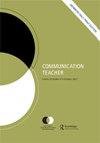Targeting an audience: A discussion of relevant variables and a test of priming
IF 0.4
Q4 COMMUNICATION
引用次数: 0
Abstract
“Targeting an Audience: A Discussion of Relevant Variables and a Test of Priming” is a teaching activity created to further students’ knowledge of persuasive message reception and priming—a persuasion tactic often used in advertising by brands. Explanations of intended courses, learning objectives, and rationale are provided to help instructors understand why this activity may be impactful in their classrooms. Additionally, advice for facilitating the activity, including information on the materials, preparation, and a breakdown of the activity’s two parts, is provided as a guide for instructors to add this activity to their lesson plan. This activity was written for submission after successful facilitation in a graduate-level communication course, although applications extend beyond this level. An appraisal of the activity suggests limitations and variations of the activity. Originally developed as part of an instructional discussion for a graduate seminar in persuasion, “Targeting an Audience: A Discussion of Relevant Variables and a Test of Priming” is presented in this manuscript as an engaging activity to introduce any college-level student to the ideas of persuasive message reception and priming. Myers et al. (A curricular view of communication course offerings of national communication association department members. Communication Education, 70(4), 421–434, 2021) found persuasion to be the second most commonly offered course among National Communication Association department members, which may suggest that materials and activities to teach persuasion, such as presented in this manuscript, are in high demand. Courses: This activity is intended for use as part of a persuasive communication course lesson in which persuasive message effects on receivers are discussed. Although originally developed for a graduate seminar in persuasion, this activity may also be facilitated in undergraduate persuasion or introductory communication courses. Objectives: By participating in this activity, students will: (1) be able to define individual variables that influence a message receiver; (2) understand the effect of the variables on message reception through discussion of basic research findings and personal experiences; (3) apply the variables to suggest the “target audience” of real-life advertising examples; and (4) understand that receivers are not blank slates.目标受众:相关变量的讨论和启动的检验
“目标受众:相关变量的讨论和启动效应的检验”是一项教学活动,旨在加深学生对说服性信息接收和启动效应的认识。说服性信息接收和启动效应是品牌广告中常用的一种说服策略。提供了预期课程、学习目标和基本原理的解释,以帮助教师理解为什么这项活动可能对他们的课堂产生影响。此外,还提供了促进活动的建议,包括材料信息,准备工作,以及活动的两个部分的细分,作为指导教师将此活动添加到他们的课程计划中。这项活动是在研究生水平的沟通课程中成功促成后提交的,尽管应用范围超出了这个级别。对活动的评估表明活动的局限性和变化。最初作为说服研究生研讨会教学讨论的一部分,“目标受众:相关变量的讨论和启动测试”在这份手稿中作为一项引人入胜的活动,向任何大学水平的学生介绍说服性信息接收和启动的概念。Myers等人(国家传播协会部门成员的传播课程设置的课程观)。《传播教育》(Communication Education), 70(4), 421-434, 2021)发现说服是全国传播协会部门成员开设的第二大课程,这可能表明,教授说服的材料和活动,如本文所呈现的,需求量很大。课程:本活动旨在作为说服性沟通课程的一部分,讨论说服性信息对接收者的影响。虽然最初是为研究生的说服研讨会开发的,但这种活动也可以在本科生的说服或介绍性沟通课程中得到促进。目标:通过参与这项活动,学生将:(1)能够定义影响信息接收者的单个变量;(2)通过对基础研究成果和个人经历的讨论,了解各变量对信息接收的影响;(3)运用变量建议现实生活中的广告实例的“目标受众”;(4)理解接收者不是一张白纸。
本文章由计算机程序翻译,如有差异,请以英文原文为准。
求助全文
约1分钟内获得全文
求助全文

 求助内容:
求助内容: 应助结果提醒方式:
应助结果提醒方式:


